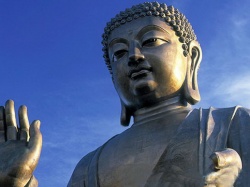Voice of the Nembutsu
Try to recite the Nembutsu and the Pure Land (the Land of Ultimate Bliss) will soon be realized in your mind.
- Special thanks to Monsu Koryu Nakamura Shonin, Chief Priest of Jodo Shu, for this edition of Nembutsu recitation.
The Significance of Nembutsu
In Jodo Shu, we value the recitation of the nembutsu, "Namu Amida Butsu", because it means "total reliance upon the compassion of Amida Buddha."
When do we recite Nembutsu ?
In Jodo Shu, there are three different times to recite the nembutsu. The first type of recitation is done in our everyday life, and is called "Jinjo Gyogi." It is considered a "daily" nembutsu. The second type of nembutsu is called "Betsuji Nembutsu" and takes place only on a pre-determined date and time. The third type is called "Rinju Gyogi." It is chanted on one's deathbed just before the believer is welcomed into the Pure Land (Jodo),
Three different ways to recite Nembutsu
1) Junen:
The recitation of Namu Amida Butsu ten times. The teaching of Junen appears in the Eighteenth Vow of Amida Buddha in Sutra of Immeasurable Life (Muryoju-kyo). It states that every person who recites the nembutsu ten times shall be saved. "Namu Amida Butsu" is recited eight times in one breath without voicing "tsu," a breath is taken and the full "Namu Amida Butsu" is recited once making nine times. The final (tenth) Nembutsu is chanted with the "tsu" almost silent again, as if one has swallowed the word.
2) Nembutsu Ichie:
Nembutsu should be recited as many times as possible without limiting its number.
3) Sanshorai:
"Naam Ami Daau" is recited three times very slowly and finished with a deep bow. This is repeated three times making nine, the total number of nembutsu. Before reciting the nembutsu one must do the following:
First one does "Gassho", a most important act in Buddhism. It is accomplished by gently placing your palms together in front of your chest, without any space between the fingers. (It should be noted that this is different then the Christian pose). Gassho may be done either standing or sitting. A rosary (juzu) should be draped over your hands as seen in the photograph and the nembutsu should be recited clearly in a voice neither too loud nor too soft.
Honen Shonin taught people that it was enough to simply recite Nembutsu. He firmly believed that true Buddhism should be able to be practiced easily anywhere and at any time.
You will experience deep tranquility and the silence of peace when you abandon your ego, reflect on how ignorant and sinful you are as a human being, and leave everything to the compassion of Amida Buddha, reciting Namu Amida Butsu many times.
